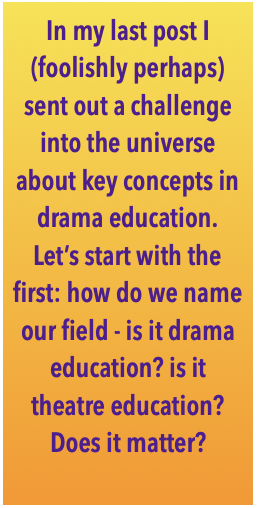Drama Tuesday - Drama Education? Theatre Education? Something else?
/If someone asks me what I do. I reply automatically: I am a drama teacher.
My most recent profession has been teaching drama teachers. Sometimes I teach theatre but it is within the scope of teaching drama.
This is something more than habit or comfort. It is a position that developed out of my role as a curriculum leader and writer.
When I found myself in a position as a Consultant and Writer for Curriculum I faced a confusing and conflicted landscape. On the one hand there were the teachers of “Speech and Drama” who were vying for status with the “Theatre Arts” teachers. There was also “Dramatic Literature” taught in English and Literature classes. There were competing syllabuses. It’s also fair to say that there was no single unifying understanding of the term drama. Add to that the overlaying of terms like drama in education and child drama and creative drama. Compared with other arts subjects such as Music and visual arts, the somewhat haphazard and opportunistic growth of drama as curriculum, meant that there was no convenient orthodoxy or curriculum codification to fall back on.
There needed to be a recasting of the ways that the terms and categories of the field are sorted. It was a one of the first tasks I attempted.
It had to be more than simply my preference or even my habit and practice. I spent time researching and drawing on different sources such as those published by NADIE (National Association for Drama in education – Australia) and from the United Kingdom such as Peter Abbs (1987), Dorothy Heathcote (1995), and the journal 2D. I also drew on my time as a Summer Fellow at Northwestern University, Evanston, Chicago and the traditions of Winfred Ward as well as the dynamism of Viola Spolin (1975). Particularly useful – because it stepped back to survey the broad field – was Richard Courtney’s The Dramatic Curriculum (1980) alerting me to the role of Play and Ritual.
Emerging from this flux of ideas was an argued model for the field. This served to underpin my work in curriculum writing in Western Australia and inform my contributions to development of National Statements and Profiles (1994) and subsequently for the Australian Curriculum: The Arts (ACARA, 2014).
Setting out the field of Drama Education
In the broad field of human experience, there are overlapping worlds of Play, Story and Ritual. Within these experiences there is a particular way of making and sharing meaning through taking on roles and enacting situation using the principles of story. Within the field of drama there are times when the Elements of Drama are shaped as Theatre. Overlapping with Drama is the wider field of the Arts and Performance.
If you put all of that into a visual model, then these overlapping fields draw from each other, interact porously. They are not discrete pods but are fluid and dynamic.
As a small animation, the conceptual model looks like this:
Facing the realities of differing points of view
Not that any of this is as simple as it is when you write it down on paper. When I proposed a curriculum workshop for the First Drama Education Congress in Oporto, Portugal, in 1992 – the founding of IDEA – we were asked to make sure that we provided translations of our abstracts for the three official languages: French, Spanish and English. Easy I thought (falling back on my first year Uni French 100) Drama = le Drame. It is always so much more than a simple transliteration of terms. As we quickly found out within the Congress, terms are enculturated, embedded in social practice and ways of thinking about the world. And people are prepared to “die in ditches” about terminology.
I know that this naming of the parts is a sometimes futile attempt at trying to make all of the atoms stand still or line up. It is always a work in progress. There is no convenient compliance or even agreement, but at least for my purposes as a curriculum writer, it made some sort of sense and had an internal coherence that stood up to scrutiny.
References
Abbs, P. (Ed.) (1987). Living Powers: The Arts in Education. London: Falmer Press.
ACARA. (2014). The Australian Curriculum: The Arts. Retrieved from http://www.australiancurriculum.edu.au/the-arts/introduction
Courtney, R. (1980). The Dramatic Curriculum. London: Heinemann Educational Books.
Emery, L., & Hammond, G. (1994). A Statement on the arts for Australian Schools. Melbourne: Curriculum Corporation (Australia)/Australian Education Council.
Heathcote, D., & Bolton, G. (1995). Drama for Learning: Dorothy Heathcote’s Mantle of the Expert Approach to Education (Dimensions of Drama). London: Heinemann.
Spolin, V. (1975). Theater Game File. In. St Louis Missouri: CEMREL.







